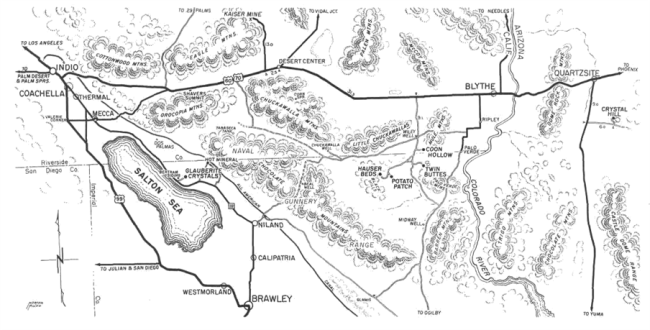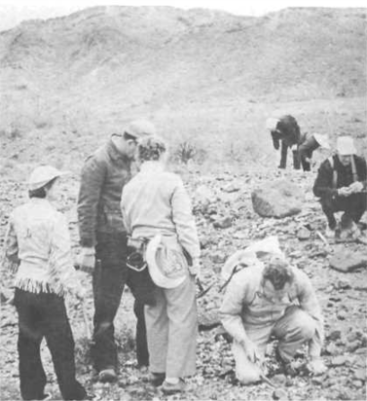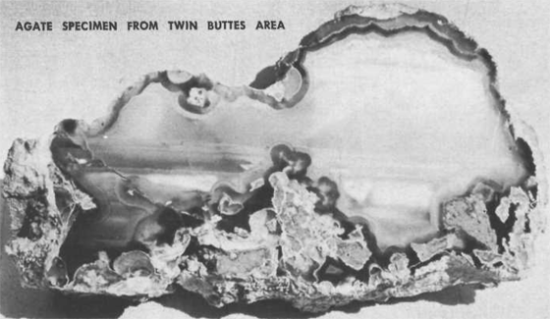From the November, 1960 issue of Desert Magazine
Wiley Well: After two decades, still the desert’s best gem-mineral field
By: Glenn and Martha Vargas
TWENTY-FIVE miles east and south of Blythe, California, is the Wiley Well District—one of the great Desert Southwest semi-precious gem fields. The well itself was dug just after the turn of the century, and for many years was an important watering place for desert travelers until paved highways replaced the pioneer trails. Wiley Well then became a source of water for livestock run in the region during years of good rainfall.
We have visited this area countless times in the past 15 years, and on only two occasions have we failed to see other rockhounds in the field. It is not uncommon to see a dozen parties on a rock search, and sometimes the number of amateur mineralogists at Wiley Well runs into the hundreds.
Such popularity is wonderful, but it has its drawbacks. At least two of the more prominent collecting fields developed by rockhounds in this district have had mining claims filed on them, and vigorous attempts made by the claim holders to keep collectors away. We have always felt that areas discovered and developed by groups of amateur hobbyists should always remain free and open to those pursuing the pleasures of the collecting hobby.
Perhaps the solution to this problem is the creation, either under county, state or federal sponsorship, of a Mineral Collectors’ Reserve at Wiley Well. The land here is nearly all in the public domain. Logically, Wiley Well itself could become the headquarters area for such a Reserve. Its water is potable, though somewhat hard. The well area abounds in good natural campsites, and is an ideal base from which to make short trips to the various collecting fields nearby.
We have expressed this idea on occasion; at first it received poor response from hobbyists. But times have changed. More and more good fields have been closed to collectors for one reason or another. The West is filling up with people—even the vast desert is no longer safe from the threat of being over-run. Of course, it will be many years before there is a hot-dog stand at Wiley Well—but the time will come—and the time to act is now, not after it is too late. We are very interested in hearing from others on this subject, and letters addressed to us, c/o Desert Magazine, Palm Desert, Calif., will receive careful attention. Let us hear what you think of the idea.
COON HOLLOW: Fire agate is a new gem material, having been known for less than 20 years. The first specimens we saw were displayed by Sam Payson of El Centra. He showed them to us one night in 1945 when we were camped at Wiley Well. Payson didn’t know what they were, and was hoping that we did—but the only thing we could tell him about the stones was that they were beautiful. He showed them to others, and the rush was on to what became known as Coon Hollow for the material that was dubbed fire agate.
By the time Randall Henderson wrote about the area in the March ’54 Desert Magazine, many nice pieces had been collected there. In fact, the material was so popular that by ’54 a few mining claims had been filed at Coon Hollow. Within three more years, claims were staked over almost the entire fire agate ground. The situation became such that claimants were carrying guns in order to keep collectors off. But, the “miners” soon found that the material was not plentiful enough to return a profit. Rockhounds want to dig their own baubles out of the ground. Few hobbyists feel inclined to pay for material that previously was theirs for the taking. Most of the claimants have drifted away, and today only a few remain. Recently we read a notice that one of them has re-opened his mine to rockhounds; all that he asks is that each visitor sign for any digging he does so that this work can apply toward the yearly assessment work necessary to keep the claim alive.
Now that the area is again open, we heartily recommend it to all hobbyists. Material is plentiful, and one need walk only a short distance from his automobile to find it.
The road to Coon Hollow leads east from a point about three miles south of Wiley Well. After you have gone a mile on this side-road, a camp area is reached. Here the road forks, the left branch going up a hill a short distance to a number of diggings. We usually take the right fork, driving ]/i-mile to a turnout near the top of a slightly sloping grade. Others in our party have found nice pieces at the parking place, but hunting is better in the wash to the northeast and on the hills beyond.
Look for knobs of chalcedony with a deep orange to chocolate color. The latter color usually indicates the best specimens.
Fire agate is very interesting material. Actually, it is a form of chalcedony made-up of thin bands of microscopic quartz crystals. These crystal bands, usually laid down in hot solutions, are only roughly parallel, and usually take the form of knobs. At some point during this band formation, a layer of iron oxide in the form of the mineral limonite is laid down and then covered with more layers of quartz crystals. This layer of limonite may be only a very few thousandths of an inch thick, and as such tends to show an irridescent play of colors. If the chalcedony (quartz crystal layer) over it is clear, this irridescence can easily be seen. Careful grinding and polishing of this clear layer down to, but not into, the limonite layer produces the fire agate stones.
The chalcedony at Coon Hollow is of a milky-to-clear material generously cut through with color layers ranging from yellow through brown. Naturally, all of the material does not have fire, but these banded pieces often produce very nice stones when cut across the bands.
On rare occasion we have found small chalcedony nodules or geodes at Coon Hollow. Those that are hollow when cut are usually lined with tiny (drusy) quartz crystals. Sometimes the crystals are in the form of stalactites. Best of all, some of these geodes will show the wavy colored banding in the cut walls. This indeed can be a treasure!
Much of the rough chalcedony is lying on the hillsides and in the washes as float, having eroded out of the slopes above. This can be good material, but it is not as plentiful as in the past. Digging for fire agate is the most profitable means of gathering material. If you dig in one of the open claims, the problem of where the chalcedony is located is usually solved for you. But, you will have to do a bit of mineral detective work if you dig in undisturbed ground: follow the float up a slope; at the point where the chalcedony markedly diminishes in quantity is the most promising place to start digging. Hidden under the ground here may be the vein from which the float is eroding. You should begin uncovering chalcedony (if you are digging over a vein) just below the surface. The material is embedded in weathered lava, and careful digging (using a brush or small broom to expose the chalcedony knobs) usually pays off. Fire agate is still waiting for you at Coon Hollow!
HAUSER GEODE BEDS: Many hobbyists are interested in geodes, for they are fun to hunt. One of the North American Continent’s most famous geode diggings is the Hauser Beds, lying at the southern tip of the Black Hills. This field has been known for over 20 years, and is still a heavy producer. Not only are there geodes still left in developed fields; there are whole deposits yet untouched in the Black Hills. Each time we visit the area, we sight new roads leading to new finds.
To reach this popular area, first described by Harold Weight in the May ’47 Desert Magazine, drive south on the main Wiley Well road two miles beyond the Coon Hollow turnoff. You will pass two roads leading off to the right—the first is to a camp area; the second is the original road to the Hauser Beds, which still is passable. At the two mile point (just before a low range of hills) is a newer road to Hauser which saves a mile of travel, and misses some sharp dips. This winding road tends south and west, and has many side-branches; but the main road is fairly easy to determine. About four miles from the Wiley Well Road, Middle Camp is reached. Branch roads lead to the east and other geode beds, but the main road tends south. If you are pulling a trailer, you had best park it at Middle Camp, for road conditions deteriorate beyond this point. A mile and- a-half beyond Middle Camp, on the left, is a road to a geode bed known as the Potato Patch, discussed below. Farther on are a number of right branches leading to other geode fields, and about five miles beyond Middle Camp is a flat area from which you can see a number of large whitish scars on a hill. This is it.
ROCKHOUNDS IN THE FIELD, WILEY WELL DISTRICT
In this area you are literally surrounded by diggings. Almost any of the old holes, after some cleaning out, will yield geodes—or you may want to hunt for float geodes and open a new hole. Opportunities here are almost unlimited. Recently we were asked to name the best place in the Southwest for a novice rockhound to visit on his first field trip. Without hesitation we chose the Hauser Beds.
If you don’t care for digging, nice specimens can be found on the dumps on the slopes below each hole. We actually picked up a whole geode, later found to be lined with amethyst quartz crystals, on one of these dumps. If you like to dig for treasure, you may have the thrill of uncovering a “nest” of geodes—by no means a rare event. Digging here is easy; the volcanic ash in which the geodes are found is powdery.
We recommend that these geodes be broken open, rather than sawed. More than 85% of the Hauser geodes contain little or no agate; their hollows more often lined with beautiful crystals. Sawing does nothing to enhance the beauty of the crystals, and the brown rock geode shell will not take even a fair polish. We crack all of our Hauser geodes by carefully chipping with a chisel along a line in about three places on one face. We choose the longer dimension, and if carefully done, we end up with two nice halves. Hitting geodes with a hammer only results in smashed specimens.
POTATO PATCH: This field lying south of the road into Hauser Beds has been badly neglected by past writers. True, the Potato Patch is not as extensive as Hauser and the digging is not as easy, but a good percentage of the Potato Patch geodes contain prized amethyst quartz crystals. Some of the finest amethyst geodes that have originated in America were found here.
After leaving the Hauser Bed Road, about W2 miles from Middle Camp, the Potato Patch Road dips into a small valley. Directly to the east, near the top of a low ridge, lie the beds. The geodes are contained in a layer of volcanic ash about a foot or two thick; the whole overlaid by a layer of lava. This makes for difficult digging, but plenty of it has been done here in the past. A pry bar and a medium or heavy hammer will help break-up the lava layer.
Agate Specimen from the Twin Buttes Area
TWIN BUTTES: In the November ’50 Desert Magazine, Harold Weight wrote about an agate field in the west-end of the Palo Verde Mountains near a prominent formation which he called Double Butte. As more visitors entered the area, two other names — “The Thumbs” and “Twin Buttes” — have been used to describe the landmark. At present, the most popular of the three names is Twin Buttes. At the time Weight wrote about this area, the road was fit for burro or four-wheeldrive vehicle. Continued penetration by rockhounds improved the road somewhat, but for several years this was a stretch to be dreaded. Then came discovery of a manganese deposit near the agate field, and a new entrance road was cut through the area. Who the miners were, we never learned, for the ore deposit played-out before we could offer our thanks for the boulevard they had created.
To reach the Twin Buttes area, travel south from Wiley Well about 5 1/2 -miles. Just after you pass the hills beyond the Hauser Bed turnoff, the road crosses a deep but easily passable wash. The Twin Buttes cutoff is on the left just beyond the wash, and can be seen winding over the small hills and washes to the east. About 1 1/2 – miles along the Twin Buttes Road, another wash is crossed. Just beyond this point, the road makes a sharp left turn, and then forks. The left branch leads to a nice camping area at the northern edge of the agate field at the foot of the buttes. We usually take the unimproved right-fork and follow it about a half-mile to its end, where there is a large parking area and a fair campground. From here a trail leads south down into a valley which contains the main agate fields. How extensive the deposit is, we do not know, for the hunting is usually so good that we seldom need go more than a half-mile beyond our car.
When this area was first worked a large number of nice nodules up to six-inches long and containing beautiful moss and banded agate were dug from a weathered lava bed. This deposit lies to the west of the trail. Further along are other signs of digging. All of these holes were productive, and may still be so, but the digging is far from easy.
The flat areas yield agate float. The white-to-yellowish material usually is poor or worthless when cut, and the best specimens are those small irregular pieces that are black with desert varnish. Careful chipping of the corner of one of these may reveal red, blue, purple or orange agate—or excellent- quality fortification agate madeup of roughly circular concentric banding. We also have found green, black and orange moss agate, and, on rare occasions, fine golden sagenite. This sagenite, made up of bundles and sprays of golden needles in a blue or purplish background, is really prize material.
The thing to strive for in this field is quality. The good pieces are seldom more than few inches long in greatest dimension. Out of most pieces we cut only a single cabochon. Our favorite method of hunting such material is to sit down on the ground and carefully search a five – to – ten foot circle, repeating this across the flat. Easiest rockhounding we know of!
If you camp at the foot of the buttes, you can reach the main field by walking up the valley and wash to the west. Hunting is good a short distance out of camp, and don’t overlook the slopes to the right as you move westward. They have produced fine material.
PALO VERDE PASS: In the eastern- end of the Palo Verde Mountains lies Palo Verde Pass. This defile contains an agate field that Harold Weight wrote about in the November ’56 Desert Magazine. Evidently, the field is an extension of the other areas to the west, for we find the material to be quite similar. At no time, as far as we can determine, was the Palo Verde Pass material plentiful, and the visits of many rockhounds have removed most of the accessible supply




